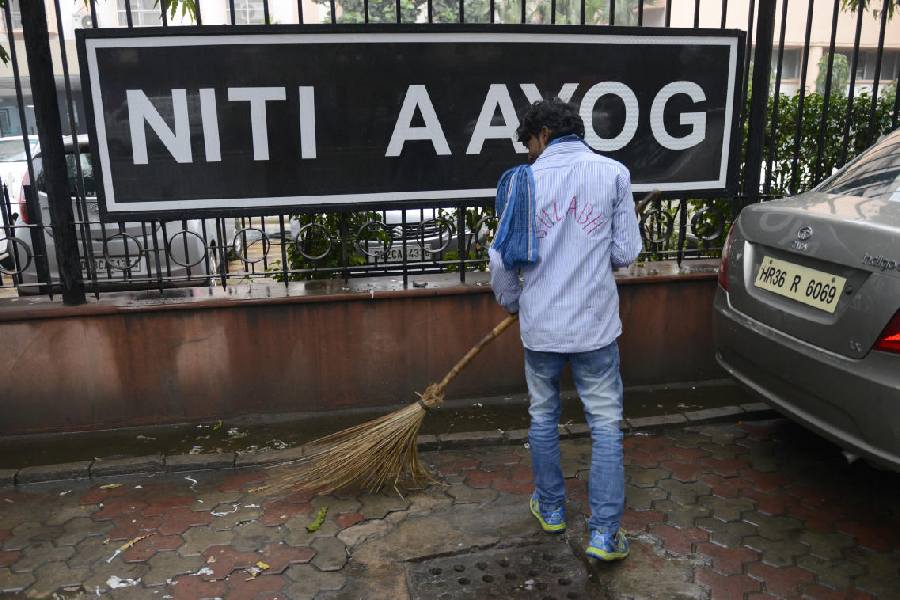Three poverty-estimation experts have independently contested a claim by the Niti Aayog CEO that suggests that poverty has fallen by over 16 percentage points in the country between 2011-12 and 2022-23.
After the National Sample Survey Office released the findings of the Household Consumption Expenditure Survey (HCES) for 2022-23, Niti Aayog chief executive officer B.V.R. Subrahmanyam said on Sunday the figures suggested poverty had fallen to 5 per cent of the population in the country.
The then Planning Commission — the Niti Aayog’s predecessor — had following the release of the HCES 2011-12 estimated that 21.9 per cent of the population was poor in India, using benchmarks worked out by a commission headed by economist Suresh Tendulkar and adjusting for inflation.
Tendulkar, appointed by the then UPA government in 2004-05, had worked out a consumption expenditure-based poverty line of Rs 447 per person per month in rural areas and Rs 579 per person per month in urban areas at the 2004-05 price levels. Anyone spending less than this amount was considered poor.
Former acting member and chairman of the National Statistical Commission, P.C. Mohanan, and retired Indian Economic Service officer K.L. Datta, author of the book Growth and Development Planning in India, said Tendulkar’s parameters cannot be applied to the findings of the HCES 2022-23 to arrive at a poverty figure.
This is because the Mixed Reference Period (MRP) methodology of the old HCES, whose findings provided the base for Tendulkar’s poverty cut-offs, was different from the Modified Mixed Reference Period (MMRP) methodology employed during HCES 2022-23, they said.
Under the MRP method, households were asked how much they had spent on food in the last 30 days and how much on education, health or clothing in the last one year.
Under the MMRP, the recall period for education, health or clothing continued to be one year. However, under food, the recall period for items like fish, meat, eggs and vegetables was one week and that for pulses and cereals was one month.
Mohanan said the MMRP method usually gave a higher average expenditure and that this was seen in the 2011-12 survey when both MRP and MMRP methods were used. However, the official estimation of poverty (21.9 per cent) was based on the MRP-driven findings alone.
Further, the survey asked questions on 405 items in 2022-23 compared with 347 in 2011-12, thus driving up the expenditure figures, the experts said.
“In the present survey, the surveyors also collected the data by making three separate visits for different segments of the questionnaire, allowing for a more detailed and improved response on the expenditure of the household,” Mohanan said.
Datta stressed that only a factsheet of the HCES 2022-23 had so far been published and not the full report. The factsheet provided the national average rural and urban Monthly Per Capita Expenditures as well as the MPCEs for the poorest and richest five per cent of the urban and rural populations, among others, but not the state-wise figures.
This, Datta said, stood in the way of a rigorous estimation of countrywide poverty levels, which varied from state to state.
Labour economist Santosh Mehrotra, a visiting professor at the University of Bath, the UK, too contested Subrahmanyam’s claim.
“The claim that poverty has been reduced to five per cent (of the population) is not credible. Had it been so, non-farm sector jobs would have increased,” he said.
“But, the fact is that 60 million people have moved from the non-agriculture sector to the agriculture sector in the last five years. Manufacturing jobs have declined since 2016.”
He added: “There has been an increase of 50 million people engaged in unpaid family labour. They are considered employed but they do not get any remuneration.”
Mehrotra said the real wages – wages adjusted for inflation --- were either stagnant or had declined.
According to the Economic Survey 2022-23, real wages have fallen in India despite an increase in nominal wages -- the actual amount the workers receive – because of
high inflation.










